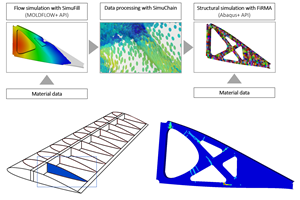New target of carbon emissions standards: Heavy-duty trucks
New proposed emissions standards in the US are designed to cut carbon pollution from heavy-duty trucks and could expand the transportation lightweighting segment of the composites industry.

In a move that could help expand the reach of composite fabrication a little more in the transportation sector, the US Environmental Protection Agency (EPA) and the US National Highway and Traffic Safety Administration (NHTSA) have jointly proposed standards for medium- and heavy-duty vehicles that would improve fuel efficiency and cut carbon pollution. The standards would cover model years 2021-2027, and apply to semi-trucks, pickup trucks, and all types and sizes of buses and work trucks. Standards for trailers would start in model year 2018.
What, exactly, the proposed standards are is difficult to discern as official news from EPA and NHTSA does not provide details. However, the net benefit of the standards, if they become regulations, are clearly outlined. First, the agencies point out:
- Heavy-duty trucks are the second largest and fastest growing segment of the US transportation sector in terms of emissions and energy use.
- The trucking industry hauls about 70% of all freight in the US.
- Medium- and heavy-duty vehicles currently account for about 20% of greenhouse gas (GHG) emissions and oil use in the US transportation sector, but are only about 5% of the vehicles on the road.
- Globally, GHG emissions from heavy-duty vehicles are growing rapidly and are expected to surpass emissions from passenger vehicles by 2030.
Second, the agencies say the proposed regulations would have this impact:
- The program would cut carbon pollution by about 1 billion metric tons. This is roughly equivalent to the GHG emissions associated with the electricity and power use from all US residences for one year
- The program would save approximately 1.8 billion barrels of oil or 75 billion gallons of fuel over the lifetime of the vehicles subject to these standards. The oil savings would exceed a year’s worth of US imports from the Oil Producing and Exporting Countries (OPEC)
- In 2027 when the standard is fully phased in, heavy-duty vehicles across all classes would achieve up to the following CO2 emissions and fuel use reductions: 24% for combination tractors designed to pull trailers and move freight when compared to Phase 1 standards; 8% for trailers when compared to an average model year 2017 trailer; 16% for vocational vehicles when compared to Phase 1 standards; 16% for pick-up trucks and light vans when compared to Phase 1 standards
Finally, and more broadly, these are the societal impacts of the proposed regulations:
- The program would save vehicle owners $170 billion in fuel costs over the lifetime of the vehicles sold.
- When fuel savings bring down the costs of transporting goods, the average household could save nearly $150 a year by 2030 and $275 by 2040 assuming all savings and costs are passed through to consumers (emphasis added).
- In total, the program would result in about $230 billion in net benefits to society over the lifetime of vehicles sold under the program. This includes fuel savings, carbon reductions, health benefits, energy security benefits, along with travel benefits, and refueling benefits.
- The benefits to society outweigh costs over the lifetime of vehicles sold under the program by about 10:1.
What all this means for the composites industry remains to be seen, but similar measures in Europe applied to passenger cars has stimulated substantial pursuit of lightweighting options that could, conceivably, be applied to heavy-duty trucks as well.
Related Content
SMC composites progress BinC solar electric vehicles
In an interview with one of Aptera’s co-founders, CW sheds light on the inspiration behind the crowd-funded solar electric vehicle, its body in carbon (BinC) and how composite materials are playing a role in its design.
Read MoreImproving carbon fiber SMC simulation for aerospace parts
Simutence and Engenuity demonstrate a virtual process chain enabling evaluation of process-induced fiber orientations for improved structural simulation and failure load prediction of a composite wing rib.
Read MoreThermoplastic composites: Cracking the horizontal body panel nut
Versatile sandwich panel technology solves decades-long exterior automotive challenge.
Read MoreTPI manufactures all-composite Kenworth SuperTruck 2 cab
Class 8 diesel truck, now with a 20% lighter cab, achieves 136% freight efficiency improvement.
Read MoreRead Next
Cutting 100 pounds, certification time for the X-59 nose cone
Swift Engineering used HyperX software to remove 100 pounds from 38-foot graphite/epoxy cored nose cone for X-59 supersonic aircraft.
Read MoreNext-gen fan blades: Hybrid twin RTM, printed sensors, laser shock disassembly
MORPHO project demonstrates blade with 20% faster RTM cure cycle, uses AI-based monitoring for improved maintenance/life cycle management and proves laser shock disassembly for recycling.
Read MoreUltrasonic welding for in-space manufacturing of CFRTP
Agile Ultrasonics and NASA trial robotic-compatible carbon fiber-reinforced thermoplastic ultrasonic welding technology for space structures.
Read More












